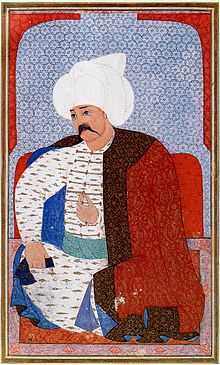
Back Selim I Afrikaans Selim I. ALS سليم الأول Arabic سليم الاول ARZ Selim I AST I Səlim Azerbaijani بیرینجی سلیم AZB Сәлим I Bashkir Селім I Byelorussian Селим I Bulgarian
You can help expand this article with text translated from the corresponding article in Turkish. (February 2024) Click [show] for important translation instructions.
|
| Selim I | |||||
|---|---|---|---|---|---|
| Custodian of the Two Holy Mosques | |||||
 16th century miniature of Selim I by Nakkaş Osman | |||||
| Sultan of the Ottoman Empire (Padishah) | |||||
| Reign | 24 April 1512 – 22 September 1520 | ||||
| Predecessor | Bayezid II | ||||
| Successor | Suleiman I | ||||
| Ottoman caliph (Amir al-Mu'minin) | |||||
| Reign | 22 January 1517 – 22 September 1520 | ||||
| Predecessor | Al-Mutawakkil III (Abbasid caliph) | ||||
| Successor | Suleiman I | ||||
| Prince-Governor of Trebizond Sanjak | |||||
| Reign | 1487–1510[1] | ||||
| Born | 10 October 1470 Amasya, Ottoman Empire | ||||
| Died | 22 September 1520 (aged 49) Çorlu, Ottoman Empire | ||||
| Burial | |||||
| Consorts | |||||
| Issue Among others | |||||
| |||||
| Dynasty | Ottoman | ||||
| Father | Bayezid II | ||||
| Mother | Gülbahar Hatun | ||||
| Religion | Sunni Islam | ||||
| Tughra |  | ||||
Selim I (Ottoman Turkish: سليم اول; Turkish: I. Selim; 10 October 1470 – 22 September 1520), known as Selim the Grim or Selim the Resolute[3] (Turkish: Yavuz Sultan Selim), was the sultan of the Ottoman Empire from 1512 to 1520.[4] Despite lasting only eight years, his reign is notable for the enormous expansion of the Empire, particularly his conquest between 1516 and 1517 of the entire Mamluk Sultanate of Egypt, which included all of the Levant, Hejaz, Tihamah and Egypt itself. On the eve of his death in 1520, the Ottoman Empire spanned about 3.4 million km2 (1.3 million sq mi), having grown by seventy percent during Selim's reign.[4]

Selim's conquest of the Middle Eastern heartlands of the Muslim world, and particularly his assumption of the role of guardian of the pilgrimage routes to Mecca and Medina, established the Ottoman Empire as the pre-eminent Muslim state. His conquests dramatically shifted the empire's geographical and cultural center of gravity away from the Balkans and toward the Middle East. By the eighteenth century, Selim's conquest of the Mamluk Sultanate had come to be romanticized as the moment when the Ottomans seized leadership over the rest of the Muslim world, and consequently Selim is popularly remembered as the first legitimate Ottoman Caliph, although stories of an official transfer of the caliphal office from the Mamluk Abbasid dynasty to the Ottomans were a later invention.[5]
- ^ Hanefi Bostan, XV–XVI. Asırlarda Trabzon Sancağında Sosyal ve İktisadi Hayat, p. 67
- ^ Ölçer, Cüneyt (1989). "Ottoman coinage during the reign of Yavuz Sultan Selim I, son of Bayezıd II".
- ^ Mansel, Philip (2011). Constantinople: City of the World's Desire, 1453–1924. John Murray Press. p. PT42. ISBN 978-1848546479.
- ^ a b Ágoston, Gábor (2009). "Selim I". In Ágoston, Gábor; Bruce Masters (eds.). Encyclopedia of the Ottoman Empire. Facts On File. pp. 511–513. ISBN 978-0816062591.
- ^ Cite error: The named reference
finkel111was invoked but never defined (see the help page).
© MMXXIII Rich X Search. We shall prevail. All rights reserved. Rich X Search